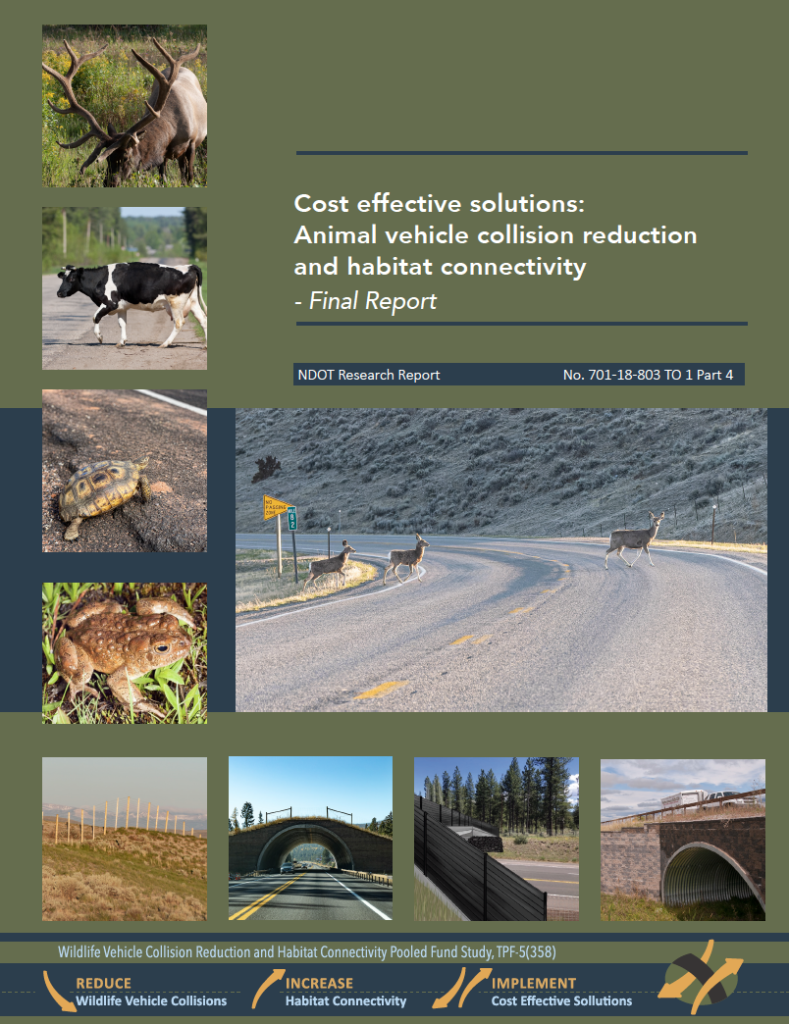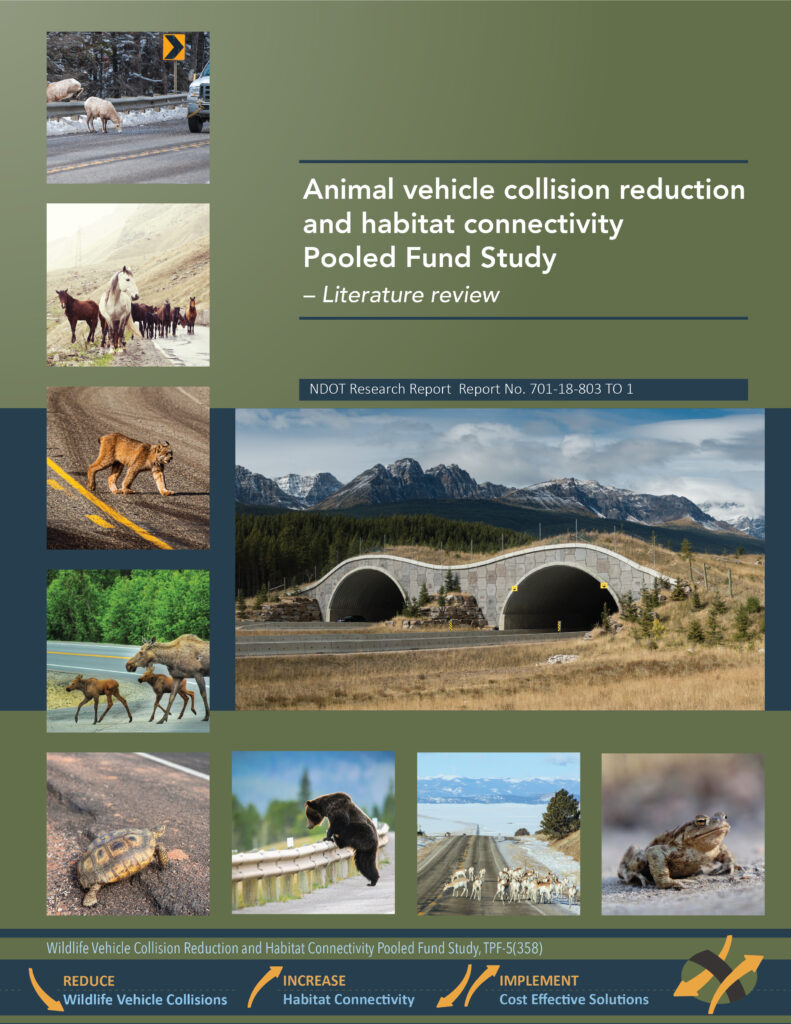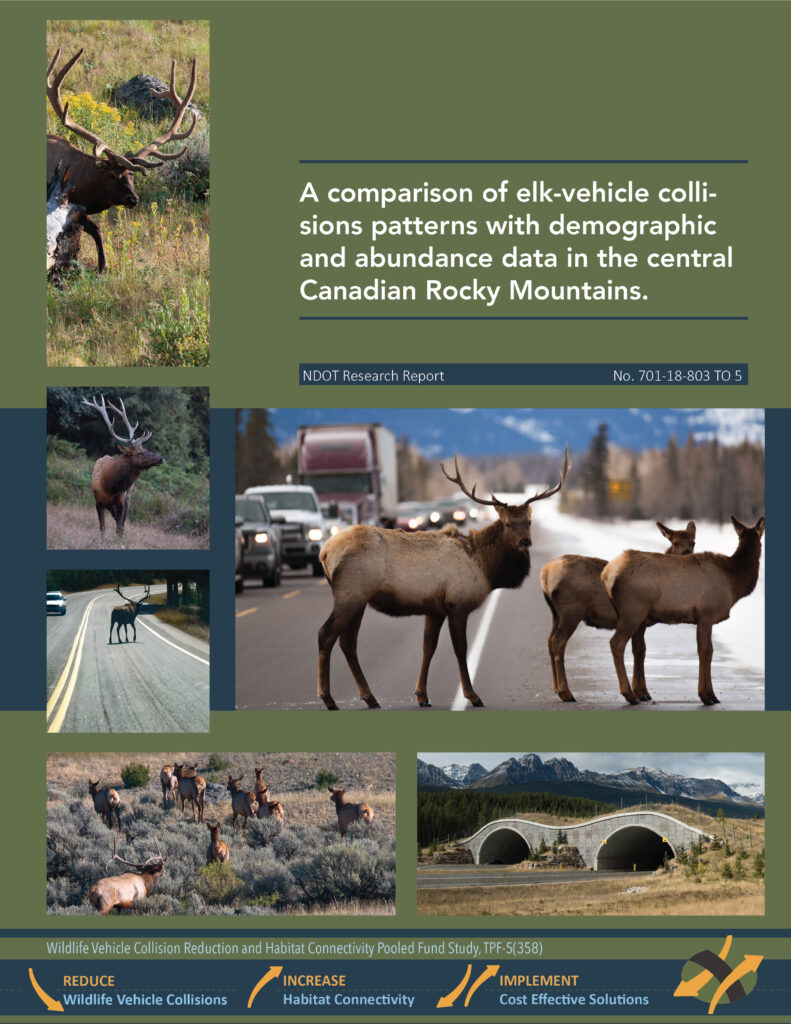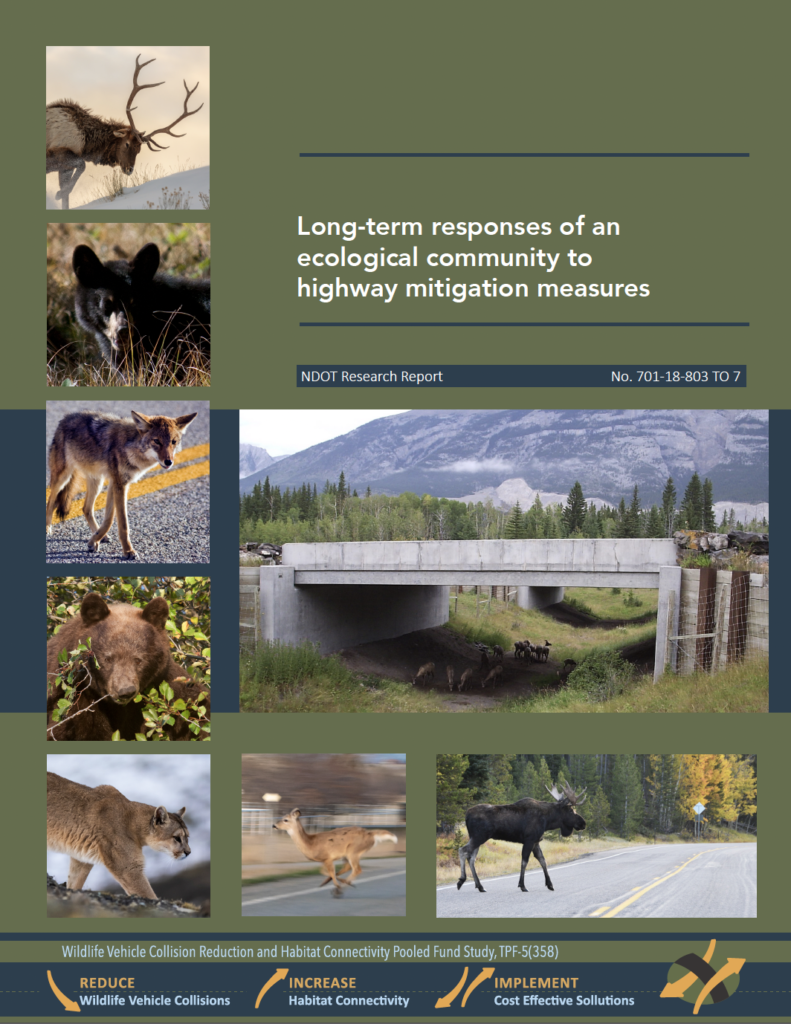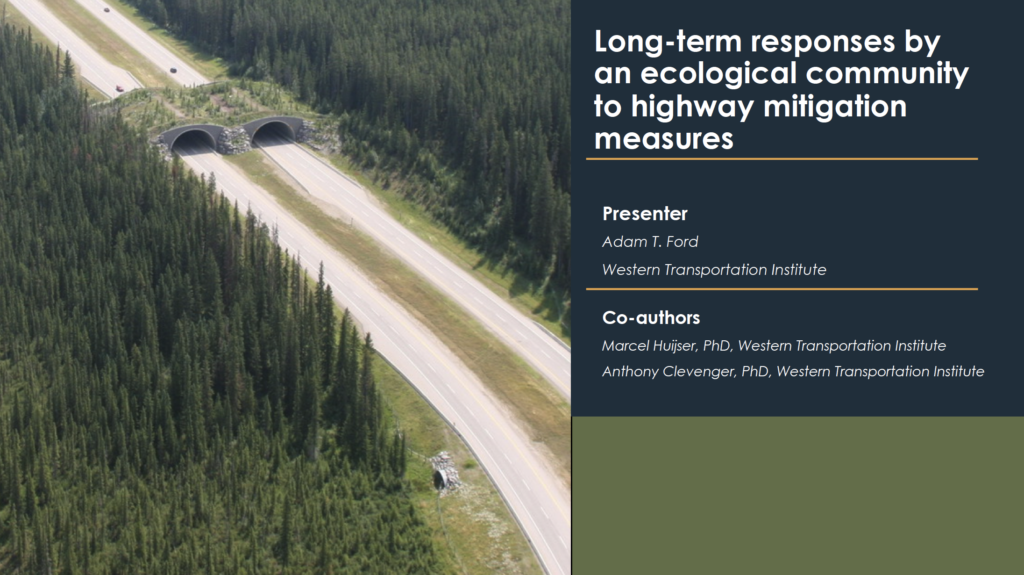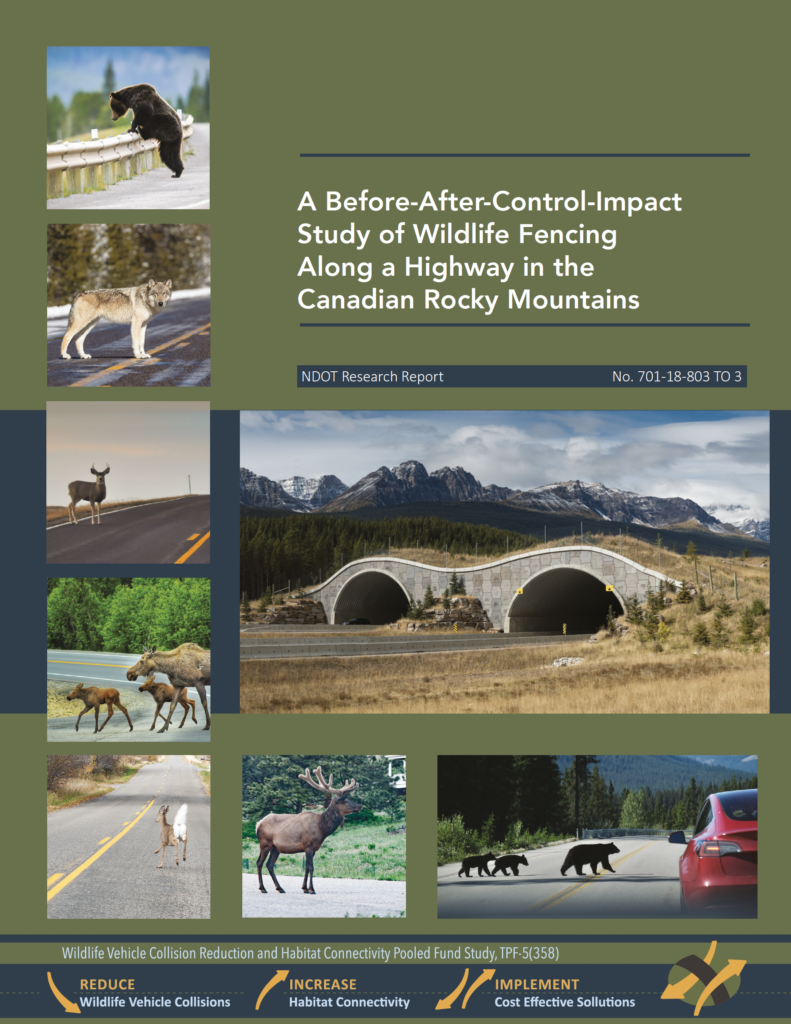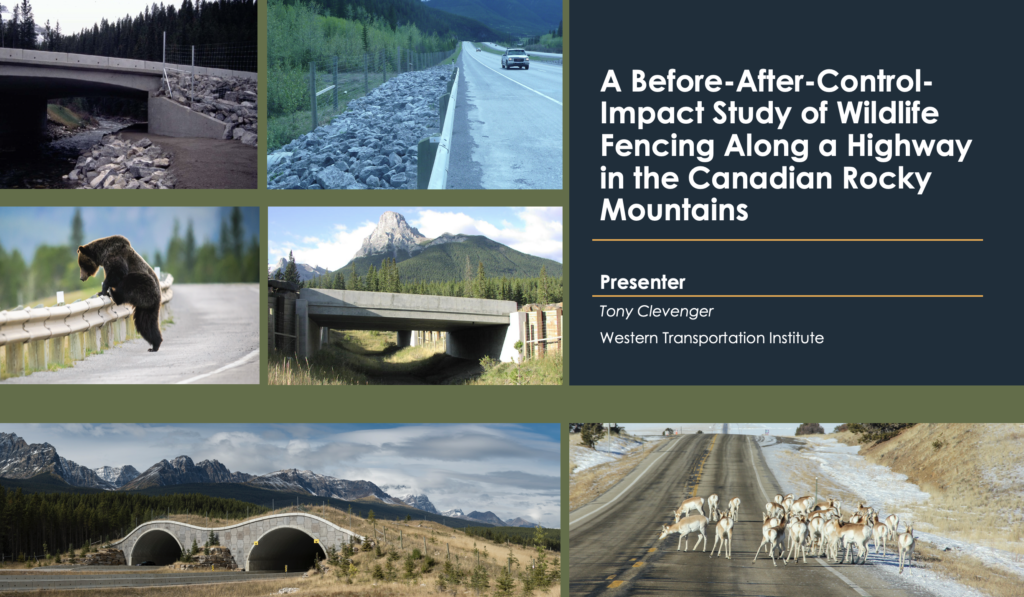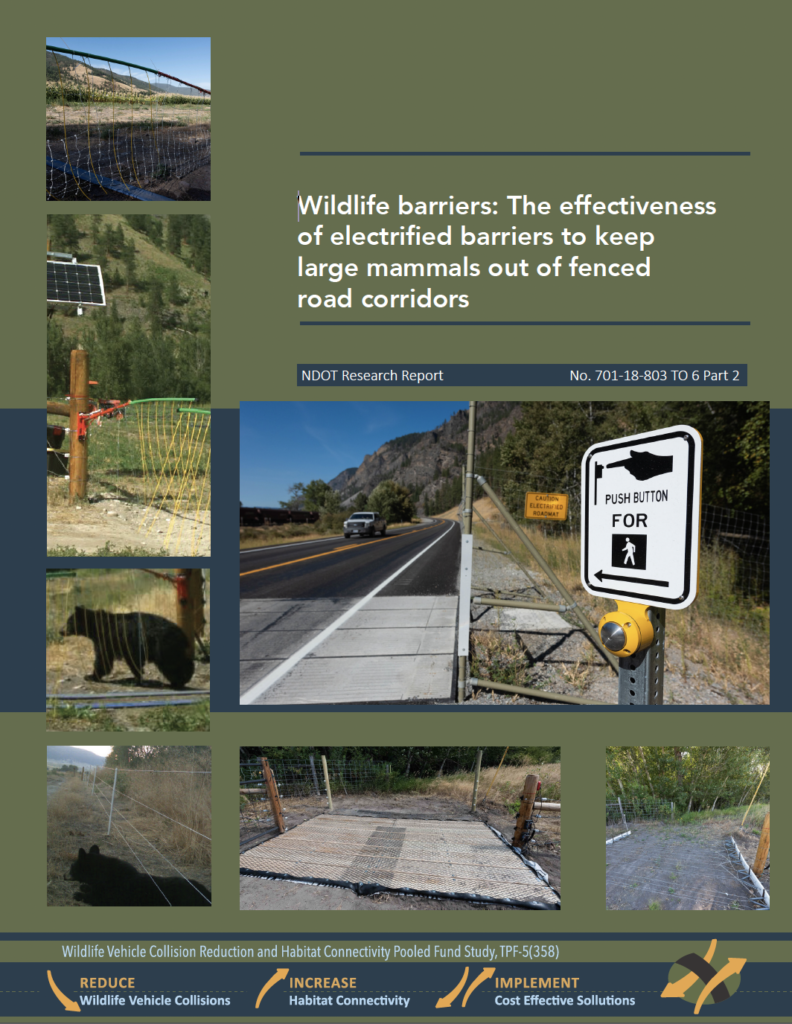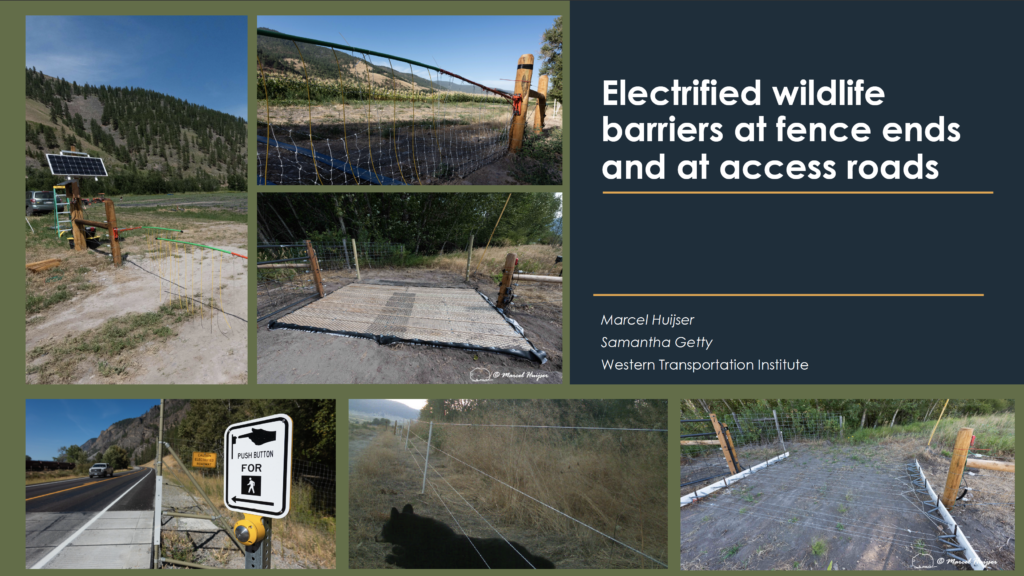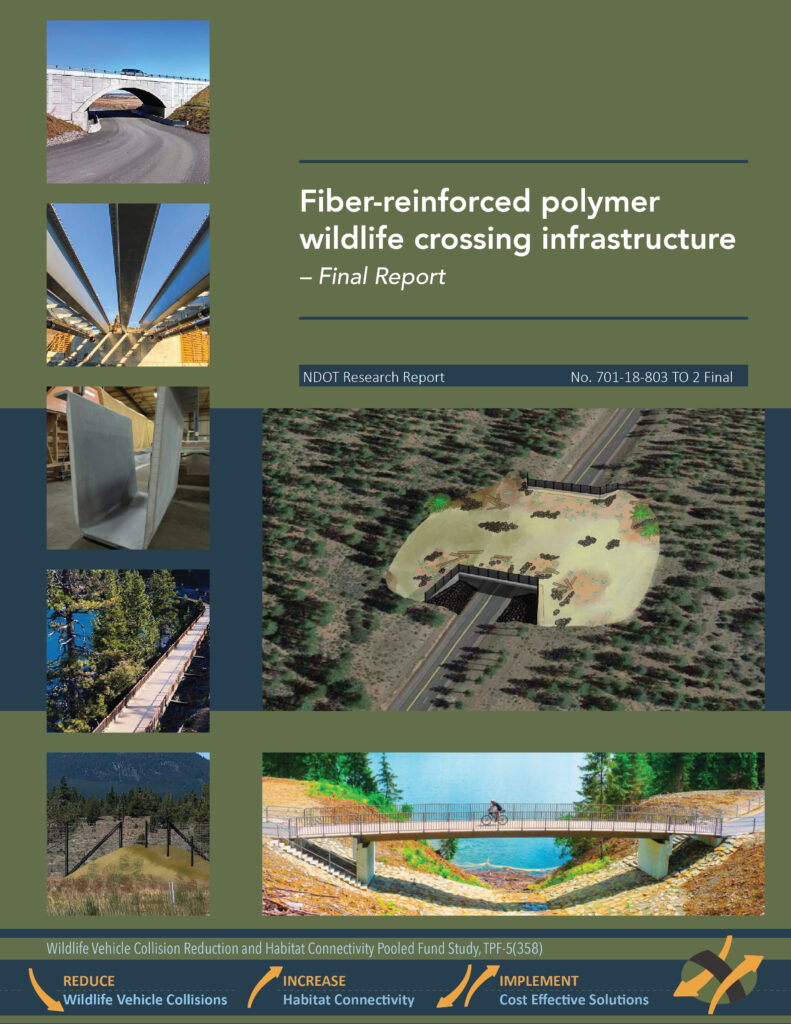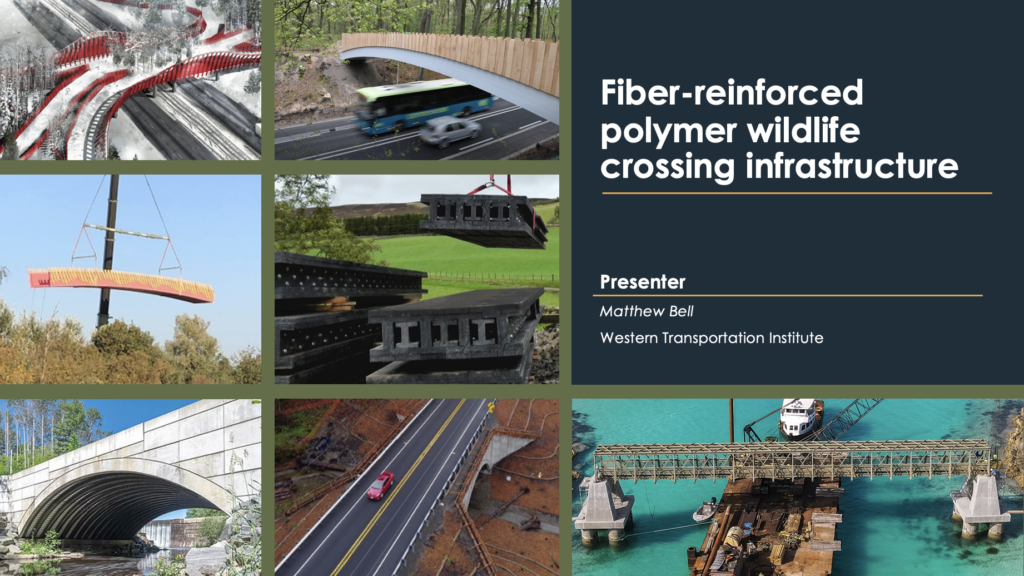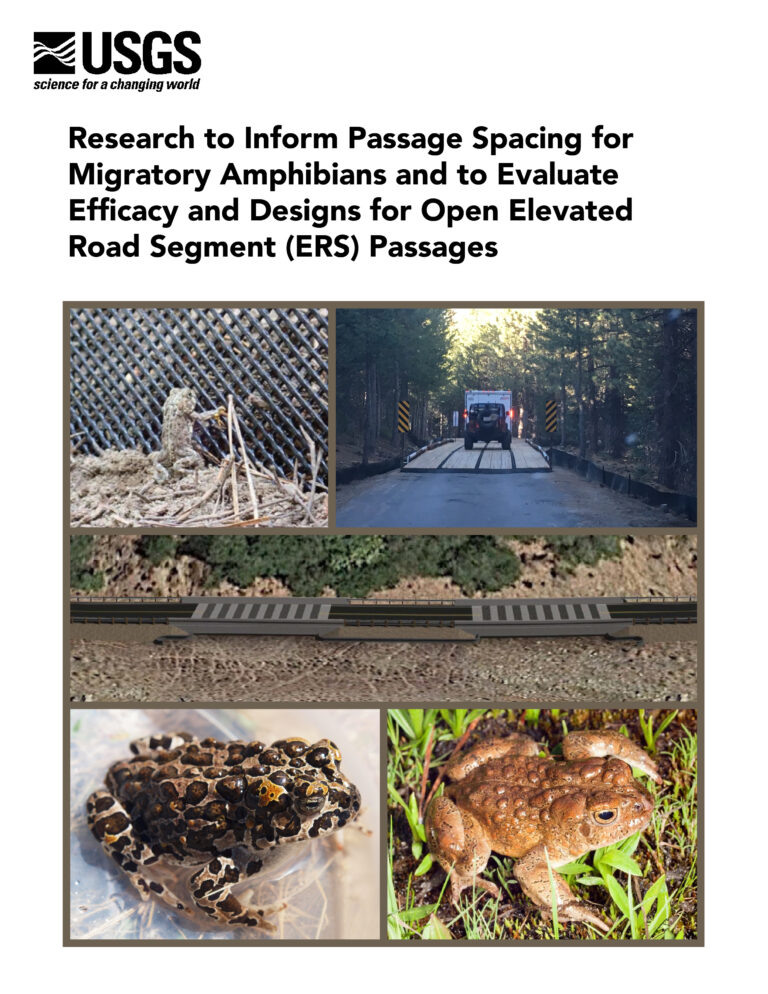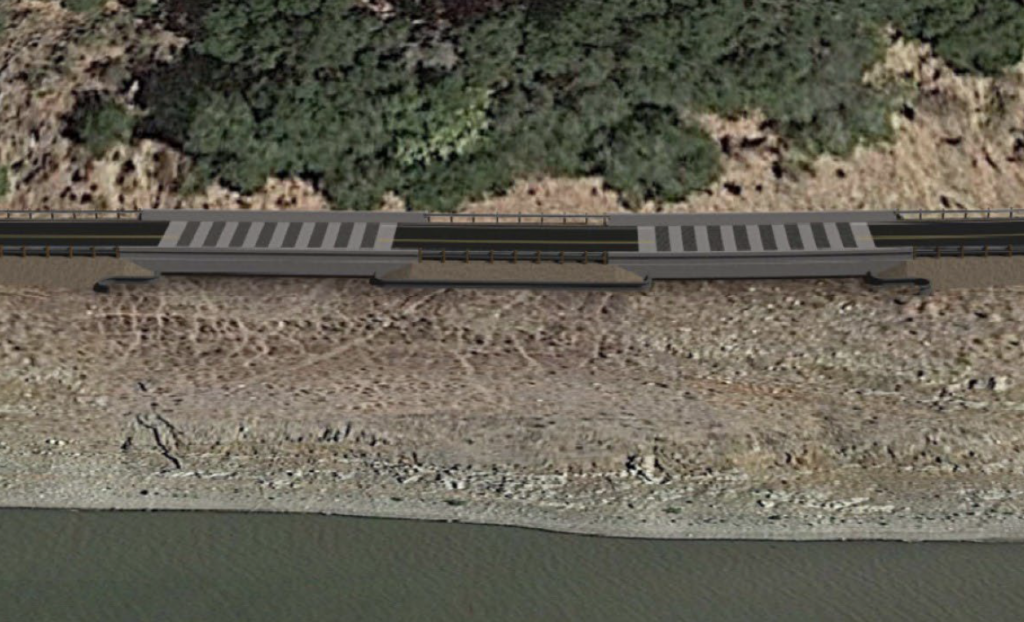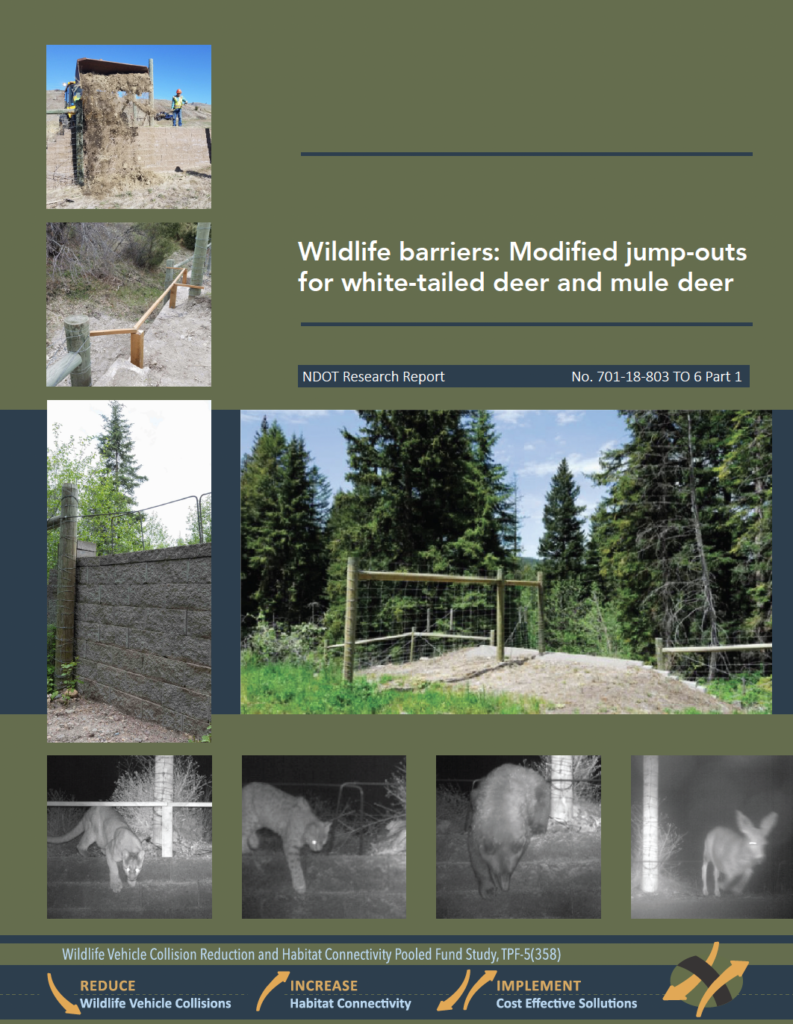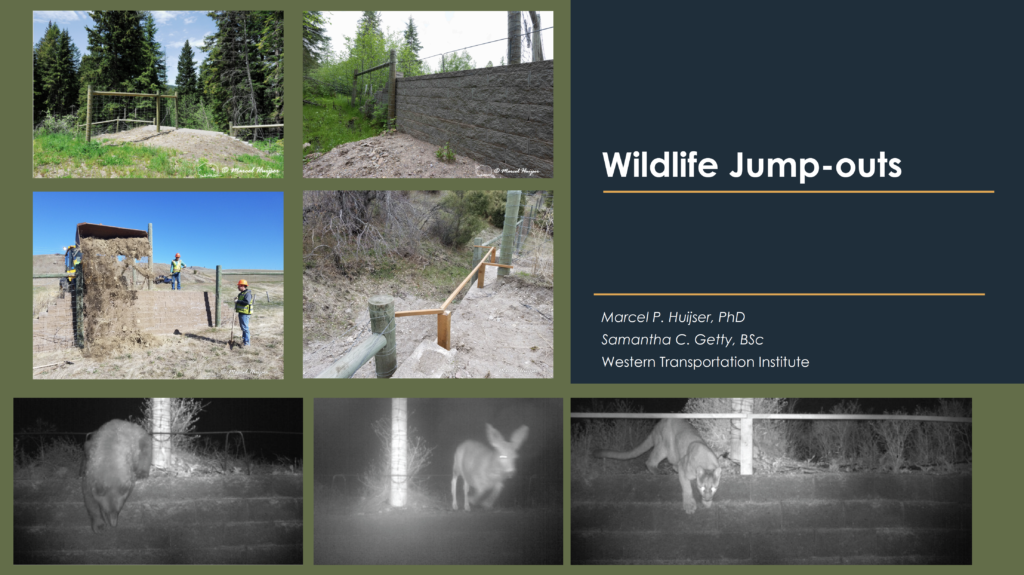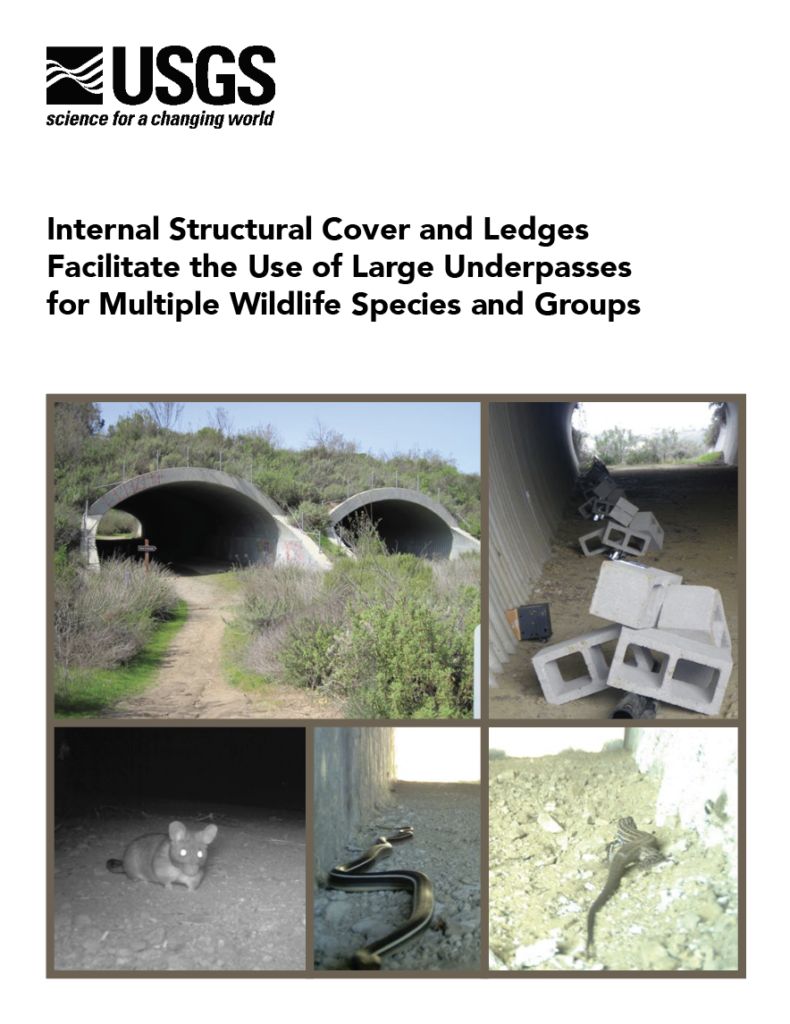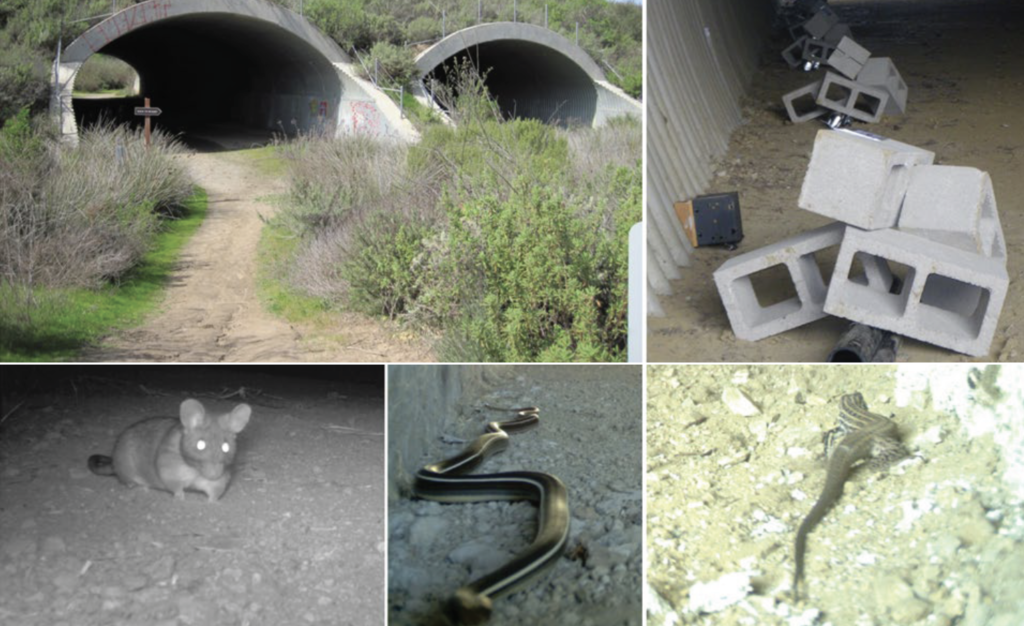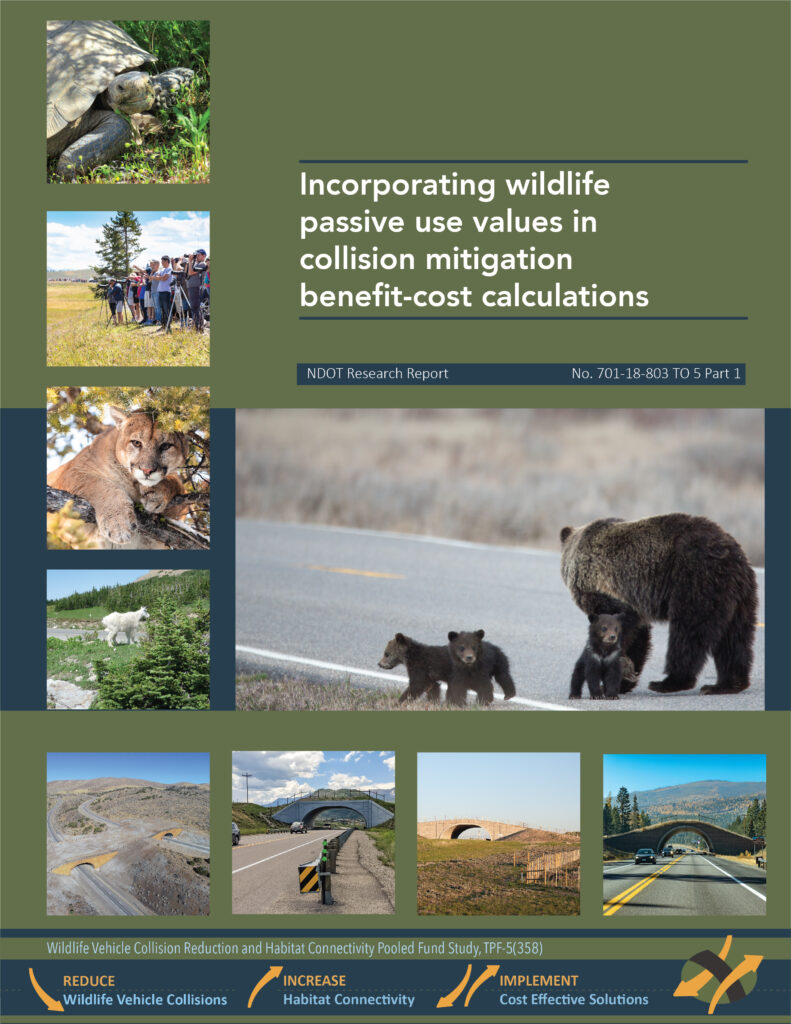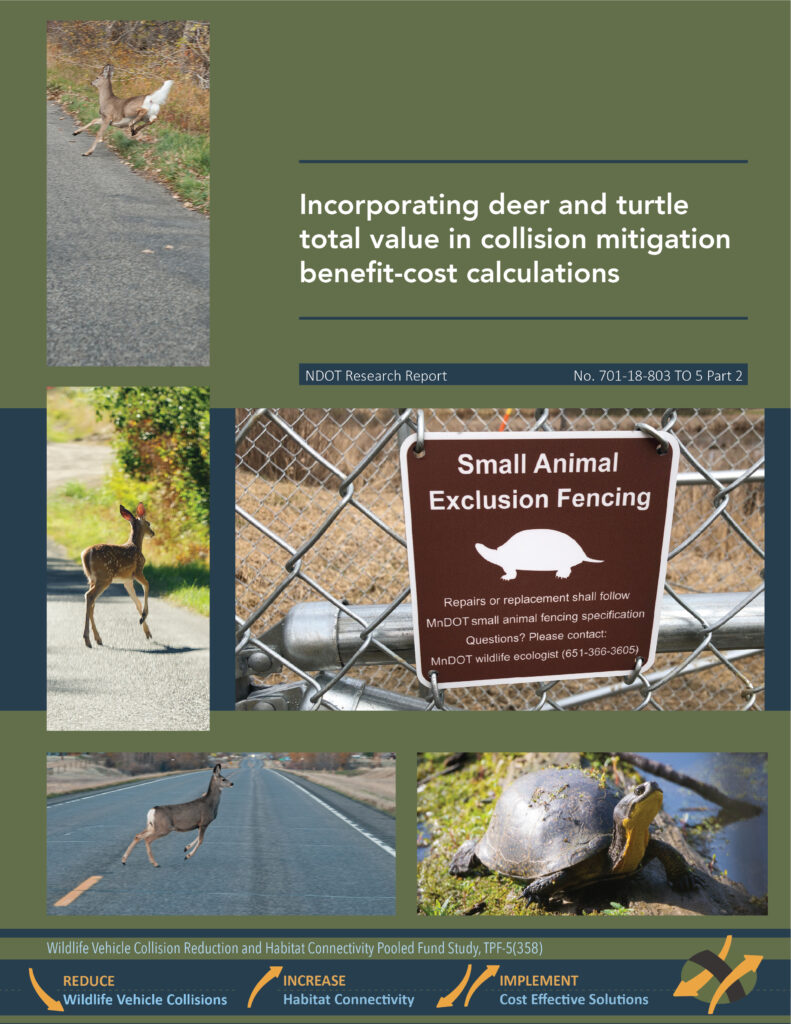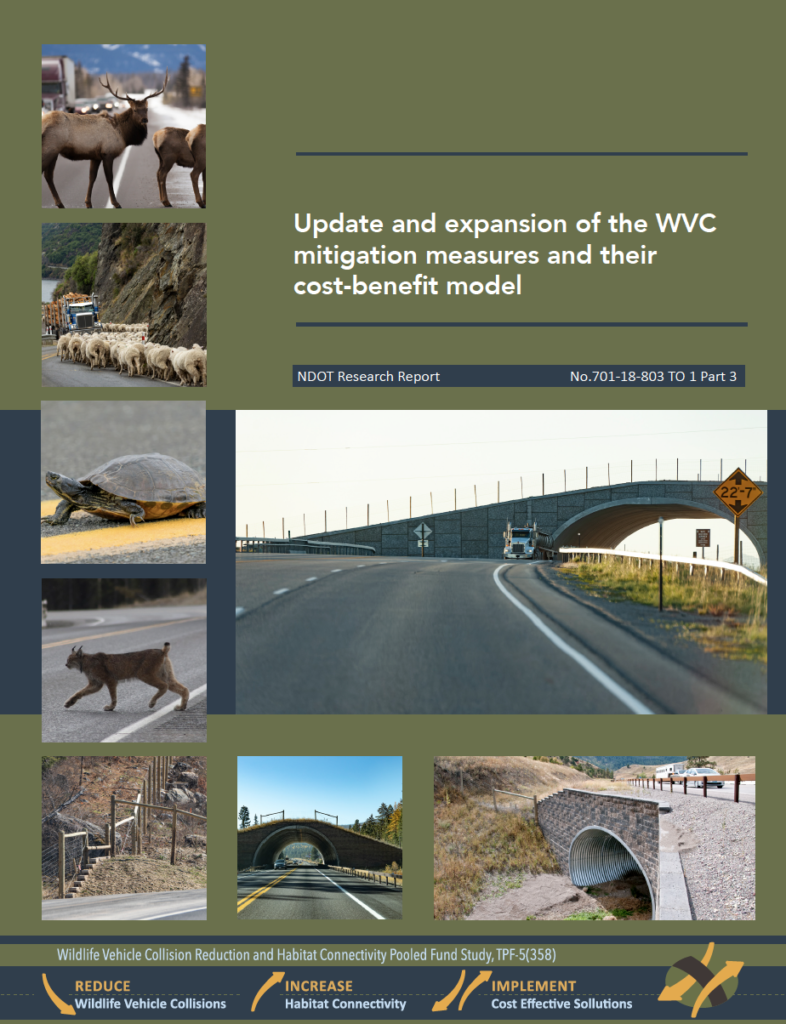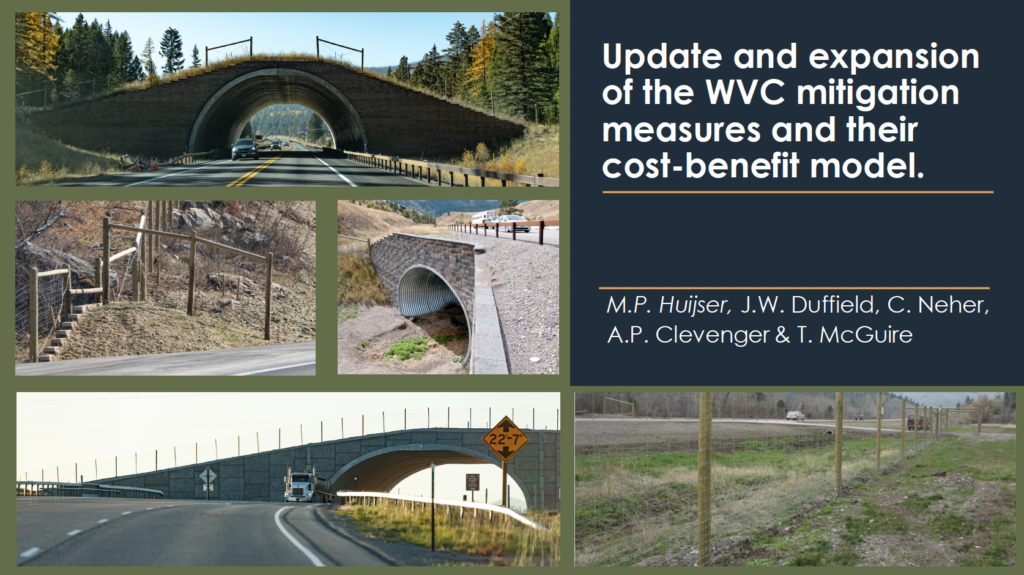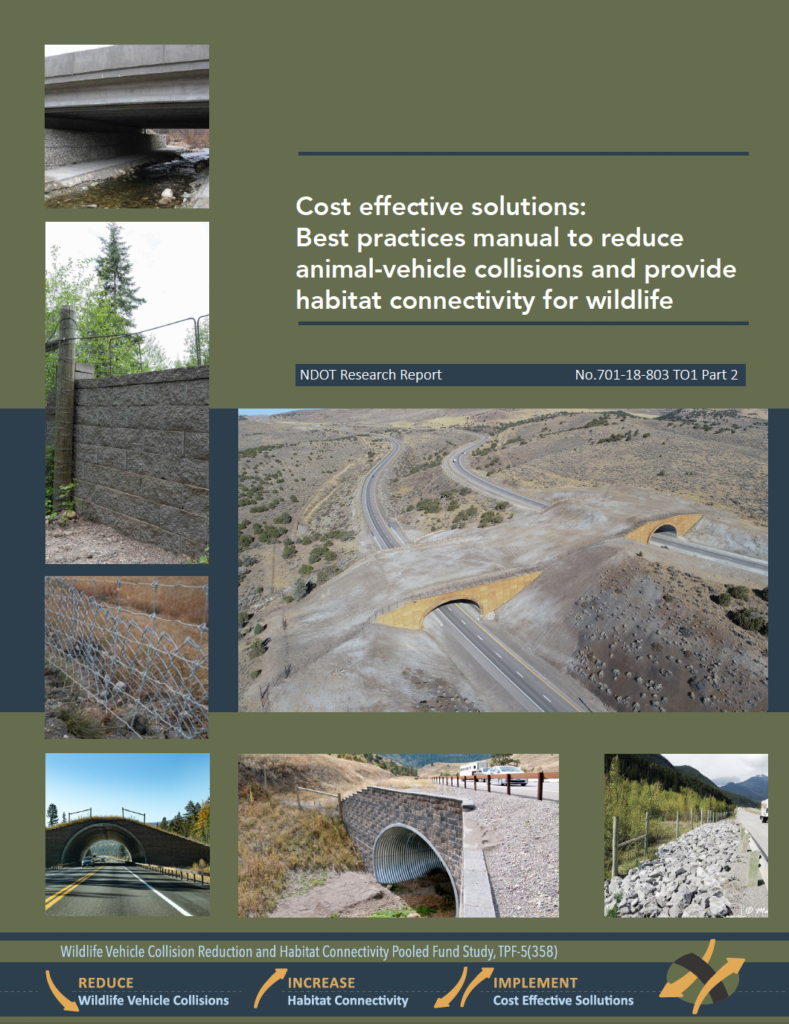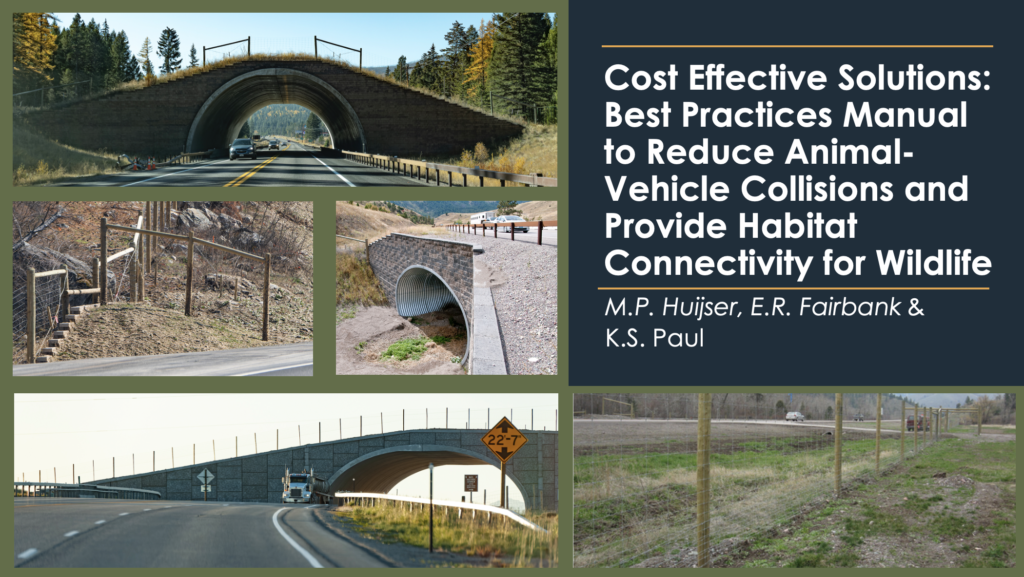The Wildlife Vehicle Collision Reduction and Habitat Connectivity Pooled Fund Study
TPF-5(358) Task 1 seeks to identify cost-effective solutions that integrate highway safety and mobility with wildlife conservation and habitat connectivity.

Ecology
Design
Economics
Abstract
Wildlife-vehicle collisions (WVCs) are a significant component of overall crashes in the US and Canada. Roads and their traffic also create partial or total barriers to the movement of wildlife, both large and small. There are several well-studied proven mitigation measures that significantly reduce WVCs, provide for safe animal passage across roads, and maintain habitat connectivity. Highly effective measures, such as overpasses and underpasses with fencing can reduce large animal WVCs by over 80% – 100% on average; yet these structures can be costly and there is room for improvement in their design, the use of new materials, adding elements that improve their use by smaller animal species, such as reptiles and amphibians and improving their cost effectiveness. This Transportation Pooled Fund Study, TPF-5(358) (TPF Study), allowed researchers to evaluate the latest information on the effectiveness of 24 different highway mitigation measures designed to decrease collisions with large wildlife, large feral and domestic animals. Also reviewed were these same measures’ ability to protect small mammals, reptiles, and amphibians from collisions. The TPF Study also explored the effectiveness of the 24 measures ability to maintain or enhance habitat connectivity. It conducted 11 different research projects that variously explored a) the costs and benefits of animal-vehicle collisions and the mitigation measures that seek to reduce them, b) the ecological effectiveness of various mitigation measures, and 3) new designs for crossing structures for a variety of species. The project developed a manual of best practices and concluded with a final report.
This report contains a summary of past research and new knowledge about the effectiveness of mitigation measures aimed at reducing animal-vehicle collisions and at providing safe crossing opportunities for wildlife. The measures are aimed at terrestrial large bodied wild mammal species, free roaming large livestock species (e.g. cattle, horses), free roaming large feral species (e.g. “wild” horses and burros), and small animal species (amphibians, reptiles, and small mammals). While mitigation is common, it is best to follow a three-step approach: avoidance, mitigation, and compensation or “off-site”mitigation. If reducing collisions with large wild mammals is the only objective, the most effective measures include roadside animal detection systems, wildlife culling, wildlife relocation, anti-fertility treatments, wildlife barriers (fences),and wildlife fences in combination with wildlife crossing structures. If the objectives also include maintaining or improving connectivity for large wild mammals, then wildlife barriers (fences) in combination with wildlife crossing structures are most effective. Measures for large domestic mammal species are largely similar, though for free roaming livestock there are legal, moral and ethical issues. For small animal species, temporary or permanent road closure and road removal are sometimes implemented, but barriers in combination with crossing structures are the most common.
Wildlife exclusion fencing has become a standard component of highway mitigation systems designing to reduce collisions with large mammals. Past work on the effectiveness of exclusion fencing has relied heavily on control-impact (i.e., space-for-time substitutions) and before-after study designs. These designs limit inference and may confound the effectiveness of mitigation with co-occurring process that also change the rate of collisions. We used a replicated before-after-control-impact study design to assess fencing effectiveness along the Trans-Canada Highway in the Rocky Mountains of Canada. We found that collisions declined for common ungulates species (elk, mule deer and white-tailed deer) by up to 96% but not for large carnivores. The weak response of carnivores is likely due to combination of fence intrusions and low sample sizes. When accounting for background changes in collision rates observed at control sites, naïve estimates of fencing effectiveness declined by 6% at one site to 90% and increased by 10% at another to a realized effectiveness of 82%. When factoring in the cost of ungulate collisions to society as a whole, fencing provided a net economic gain within 1 year of construction. Over a 10-year period, fencing would provide a net economic gain of >$500,000 per km in reduced collisions. In contrast, control site may take upwards of 90 years before the background rates of collisions decline to a break even point. Our study highlights the benefits of long-term monitoring of road mitigation projects and provides evidence of fencing effectiveness for reducing wildlife-vehicle collisions involving large mammals.
For this project the researchers investigated the effectiveness of different types of electrified barriers for varying traffic volume and traffic speed. Some barriers were investigated for carnivores only, whereas others were evaluated for both ungulates and carnivores. Finally, we combined the data from our field studies with those reported in the literature and conducted a meta-analysis to investigate the effectiveness of different types and dimensions of barriers for both ungulates and carnivores. In general, electrified barriers can be a substantial barrier to species with paws, including black bears. However, careful maintenance and monitoring is required for these measures to succeed.
Engineers and ecologists continue to explore new methods and adapt existing techniques to improve highway mitigation measures that increase motorist safety and conserve wildlife species. Crossing structures, overpasses and underpasses, combined with fences, are some of the most highly effective mitigation measures employed around the world to reduce wildlife-vehicle collisions (WVCs) with large animals, increase motorist safety, and maintain habitat connectivity across transportation networks for many other types and sizes of wildlife. Published research on structural designs and materials for wildlife crossings is limited and suggests relatively little innovation has occurred. Wildlife crossing structures for large mammals are crucial for many highway mitigation strategies, so there is a need for new, resourceful, and innovative techniques to construct these structures. This report explored the promising application of fiber-reinforced polymers (FRPs) to a wildlife crossing using an overpass. The use of FRP composites has increased due to their high strength and light weight characteristics, long service life, and low maintenance costs. They are highly customizable in shape and geometry and the materials used (e.g., resins and fibers) in their manufacture. This project explored what is known about FRP bridge structures and what commercial materials are available in North America that can be adapted for use in a wildlife crossing using an overpass structure. A 12-mile section of US Highway 97 (US-97) in Siskiyou County, California was selected as the design location. Working with the California Department of Transportation (Caltrans) and California Department of Fish and Wildlife (CDFW), a site was selected for the FRP overpass design where it would help reduce WVCs and provide habitat connectivity. The benefits of a variety of FRP materials have been incorporated into the US-97 crossing design, including in the superstructure, concrete reinforcement, fencing, and light/sound barriers on the overpass. Working with Caltrans helped identify the challenges and limitations of using FRP materials for bridge construction in California. The design was used to evaluate the life cycle costs (LCCs) of using FRP materials for wildlife infrastructure compared to traditional materials (e.g., concrete, steel, and wood). The preliminary design of an FRP wildlife overpass at the US-97 site provides an example of a feasible, efficient, and constructible alternative to the use of conventional steel and concrete materials. The LCC analysis indicated the preliminary design using FRP materials could be more cost effective over a 100-year service life than ones using traditional materials.
Additional Resources:
Journal article:
The Use of Fiber-Reinforced Polymers in Wildlife Crossing Infrastructure
Evaluating the effectiveness of an elevated road segment to reduce road mortality and maintain connectivity between wetlands and uplands: Case study with the Yosemite toad (USGS)
Abstract
This research was conducted to; 1) help inform the distances required between crossings to provide high permeability across roads for migratory amphibians (i.e., Yosemite toad), 2) to assess the permeability of a new passage design for amphibians and other small animal species, and 3) to provide engineering evaluation of this concept for primary roads and highways.
1) Although the sample size was low due to severe drought conditions in the last two years of the study and sampling constraints, we found similarities between the fence movement behavior of Yosemite toads and other migratory amphibians. Approximately 90% of toads were estimated to move 20 m or more along the fence, with an average distance of 46 m before “giving up”. These preliminary results suggest that passages spaced within 20m of one another along Yosemite toad migratory pathways are likely to provide connectivity to 90% of the population.
2) Initial results of passage permeability showed that the elevated road segment (ERS) crossing has a high potential to provide increased connectivity for Yosemite toads and a wide range of other amphibian, reptile, and small mammal species while greatly reducing road mortality.
3) The ERS concept designs, engineering evaluation and guidance document for primary roads and
highways provide a starting point for local and DOT engineers to design and build permanent ERS structure(s) to enhance the movement of small wildlife, particularly for, but not limited to, migrating amphibians over wide stretches of roadway.
Journal article: Elevated road segment (ERS) passage design may provide enhanced connectivity for amphibians, reptiles, and small mammals. DOI: https://doi.org/10.3389/fevo.2023.1145322
Webpage: USGS reptile and amphibian road ecology. https://www.usgs.gov/centers/werc/science/reptile-and-amphibian-road-ecology
The height of the jump-outs should be low enough for the target species to readily jump down to the safe side, or the habitat side, of the fence. At the same time, the jump-outs should be high enough to discourage animals that are on the habitat side of the fence from jumping up into the fenced road corridor. Previous research along US Hwy 93 North in Montana showed that only about 32% of the mule deer and about 7% of the white-tailed deer that appeared on top of the jump-outs, jumped down to safety. For this project, 10 of the jump-outs along US Hwy 93 North were lowered in height and provided with a bar on top. The height of the bars (made from rebar) and their setback from the vertical face of the jump-outs was adjustable and the researchers applied 4 different treatments: 2 different heights (18 and 15 inches) and 3 different setbacks (4, 12, and 15 inches). The overall effectiveness of the lowered jump-outs in allowing white-tailed deer to jump down, regardless of the height and setback of the bar, was only just above 5% (no improvement). For mule deer the effectiveness of the lowered jump-outs in allowing them to jump down, regardless of the height and setback of the bar, was about 64% (this was double the effectiveness of non-modified jump-outs).
We conducted a 2-year Before-After Control-Impact (BACI) study in 8 large wildlife road underpasses connecting upland habitats of San Diego County. After a single year of monitoring using highly sensitive passive infrared cameras, internal structure/cover treatments of repeating cinderblock rock piles were added to one-side within 4 of the underpasses and all passages were monitored for an additional year. Our objectives were to: 1) determine if wildlife species were currently using or avoiding these wildlife underpasses, and 2) to determine the effectiveness of adding cover structures within underpasses to enhance their use by smaller vertebrate species and groups. Because many underpasses also contained narrow ledges along the interior walls, we were also able to evaluate the use of these ledges by small animal species. Overall, we analyzed responses of 13 focal groups: lizard, mouse, rat, snake, squirrel, rabbit, roadrunner, skunk, raccoon, fox, bobcat, coyote, and deer. Prior to placement of any underpass treatments, model estimates for the relative activity of most animal groups were not significantly different within vs. outside the underpasses. However, in comparison to exterior habitat, mice and bobcats were significantly more active within the underpasses potentially indicating preference, while activity of rabbits and roadrunners were significantly lower within the underpasses potentially indicating avoidance. Although not significant, activity within underpasses was also substantially lower than exterior for snakes, squirrels, and fox. Mice activity was significantly higher on ledges and they were often documented appearing to prey on invertebrates floors of the underpasses. Addition of structure/cover treatments were associated with significant increases in use by mice, rats, rabbits, fox, and coyotes and substantial, but not significant, increase in activity of snakes and roadrunners. Internal structures such as the cinderblock rock piles in our study as well as the boulders and downed logs recommended in many guidance documents appear to provide an inexpensive way to increase underpass use by a wide variety of species. Our results indicate that responses may be associated with trophic interactions, such as bottom-up and top-down effects. Internal structural cover can enhance habitat value by shielding moisture which in turn can support more diverse microbial communities that are often the base of food chains. Internal cover also offers protection for invertebrates and small animal species. Positive responses of small animals and their predators in our study (mice, rats, rabbits, snakes, roadrunners, fox, coyote) may provide supportive evidence for bottom-up effects as a result of increased resources. However, increased use by large predators, such as coyote, may have resulted in top-down effects from predation and competition pressure such as decreased use of underpasses by medium sized prey species (i.e., skunks) and intra-guild competitors, such as bobcats.
This project addresses the potential use of passive use economic values for wildlife to inform the mitigation of wildlife-vehicle collisions. Passive use, also known as non-use values, are the values individuals place on the existence of a given animal species or population as well as the bequest value of knowing that future generations will also benefit from preserving the species. This report provides a summary of the current literature of wildlife passive use value estimates and provides per-animal passive use values for selected species and populations. Additionally, an example of applying these values to a Montana road segment is outlined. Finally, a discussion of regional economic impacts of mitigation structure spending is outlined.
Objective
Abstract
Additional Resources:
Journal article:
Incorporating passive use values in collision mitigation benefit-cost calculations: an application to deer and turtles in Minnesota
Abstract:
This report contains an update and an expansion of a cost-benefit model for wildlife-vehicle collisions and associated mitigation measures along highways, that was originally calculated in 2007 US$ and published in 2009. The direct cost values (vehicle repair, human injuries, human fatalities) were updated for deer, elk, and moose, and expanded by including additional species: gray wolf (Canis lupus), grizzly bear (Ursus arctos), and free ranging or feral domesticated species including cattle, horse, and burro. The costs associated with collisions were also expanded by including passive use, or non-use values associated with the conservation value of selected wild animal species. The total costs (in 2020 US$) associated with a collision with deer, elk and moose were about 2-3 times (direct costs only) or about 3-4 times higher (direct costs and passive use values combined) compared to the values in 2007 US$. The passive use costs associated with threatened species (wolf, grizzly bear) were higher or much higher than the direct costs. The costs associated with mitigation measures (especially fences and wildlife crossing structures) were also updated and supplemented with new data. New cost-benefit analyses generated updated or entirely new threshold values for deer, elk, moose, and grizzly bear. If collisions with these large wild mammal species reach or surpass the threshold values, it is economically defensible to install the associated type and combination of mitigation measures, both based on direct use and passive use parameters and their associated values. The trend in increasing costs associated with vehicle repair costs, costs associated with human injuries and fatalities, and through including passive use values for wildlife is that we learn that the implementation of effective mitigation measures can be considered earlier and more readily than based on the cost-benefit model published in 2009.
The goal for this manual is to provide practical information for the implementation of mitigation measures that aim to:1. Improve human safety through reducing collisions with large animals, including large wild mammal species, select free roaming large feral species, and select free roaming large livestock species, and 2.Improve or maintain habitat connectivity for terrestrial wildlife species and selected feral species through safe crossing opportunities. This manual does not include all possible measures that can or may reduce animal-vehicle collisions and maintain or improve habitat connectivity for wildlife. The measures included in this manual are: Barriers (fences) in combination with crossing structures(for large wild mammals and for small wild animal species), roadside animal detection system, Barriers (fences), Barriers (fences) in combination with crossing structures (for free roaming livestock), and culling, relocation, anti-fertility treatment, roadside animal detection systems, barriers (fences), and barriers (fences) in combination with crossing structures(for large feral mammal species such as feral horses and burros).
Contact:
For more information about these projects or Road Ecology topics, please contact Marcel Huijser.
- Phone: 406.543.3277
- Email: mhuijser@montana.edu

